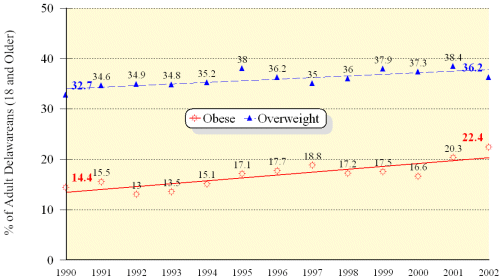Obesity Among Delaware Adults Continues to Increase
Weight and physical activity are closely related factors in health. In fact, obesity and inactivity together are the second leading cause of premature death, illness and disability in the United States. Only smoking kills more people.
Obesity is a risk factor for heart disease, diabetes, some types of cancer, bone and joint disorders, and numerous other health problems. Unfortunately, as our society becomes more sedentary and food more abundant, obesity is also become more prevalent.
Overweight and Obesity Trends
Increasing Among Delaware Adults

Source: Delaware Health and Social Services, Division of Public Health
Behavioral Risk Factor Surveillance System (BRFSS), 1990-2002.
Weight in the BRFSS is estimated using the Body Mass Index (BMI)formula, weight in kilograms divided by height in meters squared. Individuals are considered “overweight” if their BMI is between 25 and 29.9; they are considered “obese” if their BMI is greater than 30.
As shown in the graph above, overweight has increased from 32.7% of Delaware adults in 1990 to 36.2% in 2002. There is a greater increase in the prevalence of obesity in our state. The adult obesity prevalence has increased from 14.4% in 1990 to 22.4% in 2002.
Facts about overweight and obesity in Delaware:
- Overweight and obesity increase with age, until age 65. About one third of adults age 18-25 are overweight or obese. That jumps to 56% among those age 25-34 and climbs to 68% among adults age 45-64.
- The proportion of obese adults is highest among African Americans, who also have the highest incidence of high blood pressure, heart disease and diabetes. One third of African American adults report that they are obese, compared to 21% of non-Hispanic whites, and 18.4% of Hispanic adults.
- 39.7% of Delaware adults have weight within the recommended range.
- More men than women report weight problems. 25% of adult men are considered obese, compared to 20% of adult women.
- 58.6% of all adults are either overweight or obese. The prevalence of physical inactivity – sometimes called “sedentary lifestyle” – among Delaware adults is almost identical. The 2001 BRFSS showed 59% of adults getting no exercise or inadequate activity.
Fruits and Vegetables
Fruit and vegetable consumption is a good indicator of a healthy diet. Nutrition researchers and dietitians recommend that most adults should eat 5 to 9 servings of a variety of fruits and vegetables every day.
The Delaware BRFSS shows that only a small percentage of adults meet that recommendation.
- Only 19.5% of Delawareans age 18 and older eat the recommended five or more servings a day.
- 14% of adult men eat 5-a-day or more; compared to 24.4% of adult women.
- Only about 9% of adults age 18-24 eat the recommended servings of fruits and vegetables.
- The percentage jumps to 22.6% among adults age 25-34.
- 12.6% of non-Hispanic African Americans eat the recommended daily servings of fruits and vegetables, and only 10% of black men (compared to 14.5% of black women).
- 20.1% of Non-Hispanic whites eat 5 or more servings a day; and about the same percentage (20.9%) of Hispanics.
| Risk Factor | State | Kent | New Castle | Sussex |
|---|---|---|---|---|
| Overweight | 36.2% | 37.1% | 35.3% | 38.9% |
| Obese | 22.4% | 22.9% | 21.6% | 24.9% |
| Eat 5-a-Day Fruits/Veggies | 19.5% | 16.9% | 20.1% | 19.6% |
Source: Delaware Health and Social Services, Division of Public Health, Behavioral Risk Factor Surveillance System (BRFSS), 2002.



